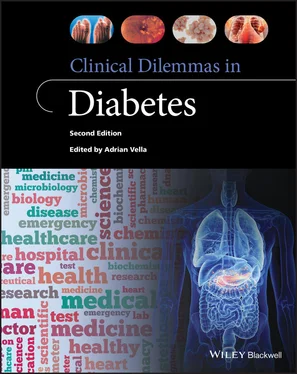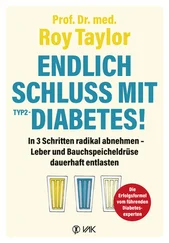The original DPP results were published after an average follow‐up of 2.8 years. The estimated cumulative incidence of DM at three years was significantly different among all groups: 28.9% in the placebo group; 21.7% in the metformin group; and 14.4% in the intensive lifestyle group. Weight loss was the main predictor of reduced DM incidence, with a hazard ratio per five‐kilogram (kg) weight loss of 0.42 (95% CI 0.35–0.51). Further, for every one kg of weight loss, there was a 16% reduction in risk of progression to DM [74].
Following randomization, DPPOS followed subjects for 15 years and metformin continued to be provided to the group originally assigned to it [75]. Over 15 years of follow‐up, the cumulative incidence of DM was 62% in the placebo group, 56% in the metformin group, and 55% in the intensive lifestyle group. At the end of DPPOS, the aggregate prevalence of microvascular outcomes – which included nephropathy, retinopathy, and neuropathy – did not differ among the 3 treatment groups. However, for women, intensive lifestyle intervention significantly reduced aggregate microvascular disease at 15 years compared to metformin and compared to placebo. Additionally, for those subjects with a baseline BMI ≥ 35 kg/m 2, the RR for the development of aggregate microvascular disease was significantly lower in the intensive lifestyle intervention group compared to the placebo group. Among participants whose most recent HbA1c was ≥ 6.5%, the intensive lifestyle intervention group showed statistically significant reductions in the aggregate microvascular outcome, retinopathy, and neuropathy compared with placebo and metformin.
Other benefits of intensive lifestyle changes were seen in DPP subjects [76]. From baseline to year three after randomization, hypertension increased in the placebo and metformin groups but decreased in the intensive lifestyle group. From baseline to year three, dyslipidemia progressed in all three groups but the progression was less in the intensive lifestyle group compared to the metformin and placebo groups. After a mean follow‐up of 3.2 years in the DPP, there were significant improvements in quality of life measures for the intensive lifestyle group, but not for the other two groups [77]. From a payer perspective, 10 years after randomization in DPP, intensive lifestyle changes were cost‐effective, and metformin was marginally cost‐saving compared to placebo [78].
In 1986, a population‐based survey identified subjects in Da Qing, China with IGT [79]. These subjects were then randomized into four groups: control group, diet only, exercise only, and diet plus exercise. At six years post randomization, the mean rate of DM was significantly higher in the control group at 66%, compared to 47% in the diet group, 45% in the exercise group, and 44% in the diet plus exercise group.
The original Da Qing participants were followed for up to 30 years after randomization to assess the effects of intervention of DM incidence, microvascular and macrovascular complications, and mortality [80]. Active intervention occurred for the first six years after randomization until 1992, after which subjects were informed of the study results and asked to continue with normal medical care. No specific interventions were offered after the initial six years, and the three intervention groups were combined into one group for analysis purposes.
Over the 30‐year follow‐up period, the intervention group had a median delay in DM onset by four years (NNT 10) compared to the control group and a significantly lower cumulative incidence of DM onset (HR 0.61) [80]. At 30 years, there were 26% fewer CVD events in the intervention group compared to the control group. The difference between the two groups continued to increase over time.
At 30 years, the incidence of retinopathy was 40% lower in the intervention group than in the control group, and incidence of nephropathy and neuropathy were numerically lower in the intervention group but not significantly different [80]. The median delay of composite microvascular disease outcome was 5.2 years in the intervention group (NNT 10). Cardiovascular and all‐cause mortality were also significantly lower in the intervention group (25.6% and 35.2%, respectively) than in the control group (45.5% and 56.3%, respectively). The median delay in CVD death and all‐cause mortality in the intervention group were 7.3 years and 4.8 years, respectively, with NNT of 10 for both outcomes.
Pharmacologic therapy for the prevention or delay of diabetes mellitus
A systematic review that included 20 randomized controlled trials examined the efficacy of metformin for the prevention or delay of DM [81]. The overall conclusion was that for at‐risk subjects, metformin compared with placebo reduced or delayed the risk of progression to DM. The incidence of DM was not significantly different when comparing metformin plus intensive diet and exercise and identical intensive diet and exercise alone.
In addition to metformin, other medications have proven efficacy in reducing progression to DM. Once‐daily subcutaneous liraglutide 3.0 mg as adjunct therapy to lifestyle modifications reduced progression to DM compared to placebo after 160 weeks [82]. In adults with elevated CVD risk and prediabetes or newly established DM, a once‐daily insulin glargine injection reduced progression to DM compared to placebo [83]. Several thiazolidinediones also have proven efficacy in reducing the progression to DM, including pioglitazone, rosiglitazone, and troglitazone [84–86]. Additionally, combined hormone replacement therapy in post‐menopausal women, glipizide, valsartan, orlistat, and acarbose also significantly reduced the progression to DM compared to placebo [87–92]. Interestingly, during the Study to Prevent Non‐Insulin Dependent Diabetes Mellitus (STOP‐NIDDM), acarbose was associated with a 49% relative risk reduction in cardiovascular events compared to placebo with a HR 0.51 (95% CI 0.28–0.95). However, the methodology of STOP‐NIDDM has been heavily criticized and the validity of the results has been questioned [93]. Many pharmacologic therapies have also been studied and shown to be ineffective in preventing progression to DM, including vitamin D, nateglinide, glimepiride, and ramipril [94–97].
Bariatric surgery for the prevention or delay of diabetes mellitus
A Swedish study enrolled a large cohort of adult nondiabetic subjects who had already chosen to undergo various bariatric surgeries including banding (19%), vertical banded gastroplasty (69%), or gastric bypass (12%), and matched them with a nonrandomized control group [98]. At the time of enrollment, 17.2% of the control group had IFG, compared to 16% of the surgical group. After a median follow‐up time of 10 years, bariatric surgery compared with usual care reduced progression to DM by 87% among subjects with IFG. Another study reported that 98.6% of subjects with prediabetic range dysglycemia had normal FPG following gastric bypass [99].
Exercise and diet for the prevention or delay of diabetes mellitus
A systematic review and meta‐analysis included 28 studies with 1 261 991 subjects and investigated the role of physical activity in reducing progression to DM [100]. Overall, for those who achieved 11.25 metabolic equivalent of task (MET) hours/week (equivalent to 150 minutes/week of moderate activity) there was a risk reduction of 26% for DM. Further risk reductions occurred at greater MET hours/week. The Health Professionals Follow‐up Study showed that engaging in weight training or aerobic exercise for at least 150 minutes/week was independently associated with a lower risk of DM of 34% and 52%, respectively [101]. The greatest reduction in DM risk was seen in men who engaged in both aerobic exercise and weight training for at least 150 minutes/week, with a risk reduction of 59%.
Читать дальше












